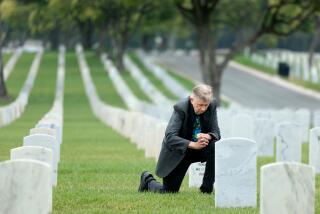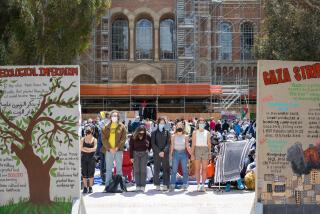Perot’s War Against the Vets’ ‘Wall’ : Monumental battle: His tactics in fighting the original design reveal much about the man who would be President.
- Share via
On March 14, 1983, former Atty. Gen. Elliot Richardson wrote to the Vietnam Veterans Memorial Fund that Ross Perot “has hired a mean lawyer. . . . I have known Roy Cohn since 1947, and if you want me to make him feel embarrassed for taking Ross Perot’s cause, I would be glad to oblige.” Cohn was the notorious former aide to the late Sen. Joe McCarthy.
For three years, from 1981 through 1984, the design of the memorial--”the Wall”--was the subject of a bitter dispute that went beyond aesthetics, mixing in patriotism, national symbols, personal pride and anger.
Leading the effort to block “the Wall” was Ross Perot. The episode reveals much about the man who would like to be President of the United States.
In 1979, we--the Vietnam Veterans Memorial Fund-- asked Perot for help, and he gave $171,000 for a national design competition, to be judged by top architects and sculptors. We needed help because so few people believed in our project. Perot said that he had earlier tried to get a Vietnam veterans memorial built in Washington, to be funded with the help of schoolchildren, “the future warriors of America.”
The competition became the largest in U.S. history, with 1,421 entries. When the winner was announced--21-year-old Yale architecture student Maya Lin--Perot told the fund’s president, Jan Scruggs, “You’ve made a big, big mistake.” At first, opponents wanted something other than the Wall; as the struggle went on, they fought for compromises: for it to be white rather than black, above ground, with a tall American flag at the vertex and the names listed alphabetically rather than by date of death.
Perot’s position was that most of the former POW/MIA’s he’d talked to disliked the design, and he offered to fund a nationwide poll--a kind of “town meeting”--to see what Americans thought. We held that most Americans, including vets, liked the Wall, and that the experts who evaluated the design entries represented all Americans. Furthermore, white stone would keep the Wall from being a true mirror, and alphabetical lists lumped together people with the same name, depriving them of individuality.
The perceived stakes got very high: “Ah’ll wap you out,” Perot told me.
The storm Perot created in Washington held up construction. We offered to add a statue and flag to the memorial. He agreed. Then Roy Cohn demanded our records, saying we had misused funds. Distrusting Cohn, we refused and asked the General Accounting Office to audit us. In 1984, the GAO concluded that our books and transactions were proper.
Perot was generous and patriotic; he was also decisive and determined. The statue we agreed on is a work of genius and redoubles the power of the memorial. But given an unconventional design, he demanded a conventional substitute. He sought a national referendum to confirm his view and support his rejection of a representative process. The same attitude marks his quest for the presidency, which bodes ill for the nation if this is how he would deal with the judiciary and Congress.
Perot also personalized the issue, repeatedly questioning my values and those of project director Robert Doubek, Jan Scruggs and the others who stood for the Wall. Having the memorial his way had become a matter of his personal honor. Most disturbingly, he showed a strong will to get even by the fierce manner in which he pursued false charges that we had misused funds.
This is a man willing to give much for his country. The telling question is whether a President Perot would show some of the qualities of mercy, compassion and reconciliation. More than any issue of economics or defense, the stratification and divisions in our country cry out for these qualities.
Whatever the election’s outcome, I hope that Ross Perot and all of us who created the Vietnam Veterans Memorial will be together at the Wall this fall for its 10th anniversary. The Wall is not just to honor, it is to heal. If we who were at the center of the Wall’s creation cannot forgive, we make the Wall a lie.
More to Read
The biggest entertainment stories
Get our big stories about Hollywood, film, television, music, arts, culture and more right in your inbox as soon as they publish.
You may occasionally receive promotional content from the Los Angeles Times.










